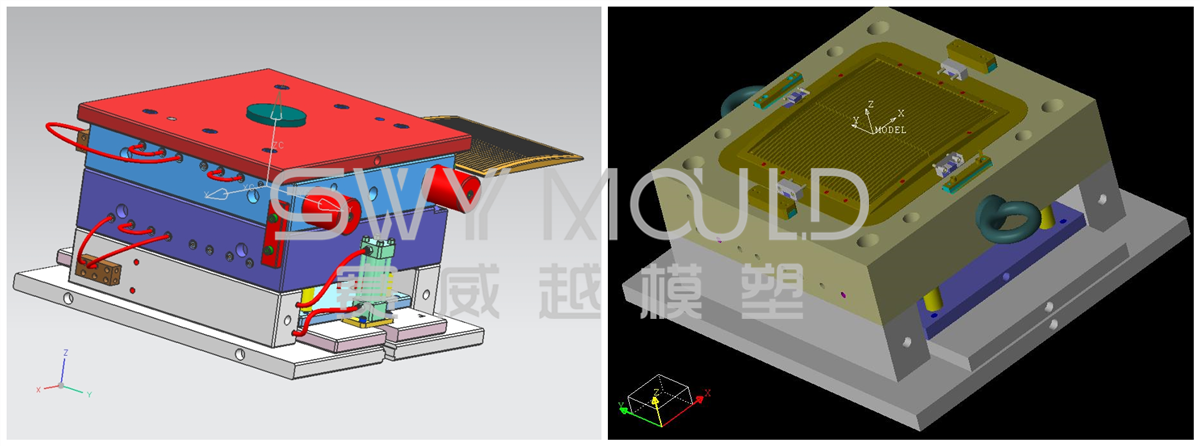

USING SCIENTIFIC MOULD-MAKING TECHNIQUE TO PROVIDE YOU WELL MOULD.
Precision(mm): 0.005
Overall size(mm): length-150; width-200; height-190
Weight: 450g
Cavity material: NAK80
Hardness: HRC38-42
Mold base: LKM
Mold structure: two plate
Service life: 300K
Concerning points of designing moulds
Design for manufacturing through injection moulding involves a lot of factors that need attention. Manufacturing requires producing the product accurately and consistently on a large scale, still, it may need to produce specific features or parts requiring extra efforts from the toolmakers. Designing for manufacturing is to remove all the possible obstacles in present and keeping a scope that if something comes in future will be solvable so the following are the guidelines that ensure your design for manufacturing is unerring and the injection mould is successful.

1. keep it simple – Design should be simple and functional. Try to simplify the complexity in design. Don’t make it unnecessarily complex. Simple lines, curves and shapes will make the design looks fashionable and pleasing.
2. Using standards – When designing a product, keep the ‘’off the shelf standard’’ components in mind to make it more affordable and efficient. Try not to specify the odd-sized screws and hard-to-source materials. People want maintainability, user-friendly simple design. It enhances the life of the design and avoids any situation that leads to the need for a redesign.
3. Design for Ease of Fabrication – Let not make it a challenge for toolmaker. Part of the product is to create a design that is appealing to the consumers and easier to manufacture.
4. Nothin walls or anything that can deform during the cooling of your mould. It requires a long time to cool off which will likely result in costly deformation, leading to the need for a redesign.
5. Avoid Undercuts – One of the most important design element is to think about where the parting lines (Borderline in which direction changes) needs to be. Avoid bulge that hindered mould when it is opened.
6. Threads – If possible, try to avoid threads in your design. They will check the design. For example where the parting lines must go and increase the change of rejects (Defective parts).
7. Radii – The small intricate parts will increase the production costs and also the chances of rejections. Try to aim for the maximum possible radius with no compromise on the design, while designing the corners or other features that require radii.
8. Design parts that align themselves with the final product – If a part is a component of a larger design, make sure it aligned with the final product. During construction, if any parts, if bend or tangle it will arise the need to reconsider the design.
9. Efficient joining and fastening options – A good design will have methods of fastening without the need for screws or glue.
10. Design components that easy to assemble – Designing part should be so easy enough so that a child could construct the final product. It should be crystal clear how the part fits into the overall design.
Designing for an appealing product that is both functional and can be produced easily can be a challenge, but one of the most important parts of the design process. Presently plastic injection moulding is the best method of mass production.
Precautions for using the mold
1. Check whether the technical parameters of the injection molding machine are set properly.
2. The injection molding table (barrel) is retracted before loading.
3. Adjust the spacing between injection molding manoeuvring stencils to make it larger than the die thickness.
4. According to the mark “ ↑ ” on the mold to lift the mould and put between the moving templates, so that the positioning ring of the mold is first introduced into the positioning hole on the template of the injection molding machine, and then the machine plate is closed to make the mold close to the substrate between the injection molding machine.
5. The side of the mold is parallel to the side of the machine board, and the mold is fixed on the injection molding machine template by pressing plates and screws.
6. After the mold is locked, the mold opening, clamping, and trial clamping force are performed, the clamping position is gradually adjusted, the clamping force is gradually increased, and the connecting rod can be straightened. It is strictly forbidden to increase the clamping force under the closed mode to avoid damage to the mold.
7. After the installation is completed, connect the waterway according to the waterway map.
8. Commissioning according to the tuning parameters of the process parameter card until a qualified product is produced.
9. For hot runner molds, please arrange professional personnel to check the wiring and ensure the matching with the temperature control box.
Taizhou Saiweiyue Mould & Plastic Co., Ltd.
ADD: No.12, Jinchuan Road, Beicheng Street, Huangyan District, Taizhou City, Zhejiang Province, 318020, China
Mobile/WhatsApp: +86-15757668880
Tel/Fax: +86-0576-89888400
E-mail: [email protected]
[email protected]

Copyright © Taizhou Saiweiyue Mould & Plastic Co., Ltd. Rights Reserved. OEM/ODM Industrial Cooling Fan Plastic Cover Injection Mold Suppliers